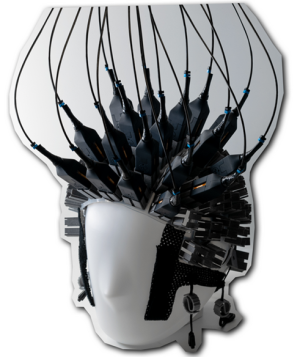Difference between revisions of "Chair newmeg"
(creation) |
(paufinage) |
||
| (3 intermediate revisions by one user not shown) | |||
| Line 1: | Line 1: | ||
| − | [[File:Logo NewMEG.png| | + | [[File:Logo NewMEG.png||300px|left]] |
| + | [[File:Capteur OPM.png||300px|right|OPM sensors]] | ||
| + | |||
| + | The ''NewMeg Marseille'' project is a collaborative project between the [https://ins-amu.fr/dynamap DynaMaP team] of INS and the [https://www.mag4health.com/ Mag4Health] company. The project will take place at the [[Main_Page|magnetoencephalography platform]] of Marseille. The project is funded in part by the [https://www.univ-amu.fr/fr/public/la-fondation-amidex A*Midex] industrial chair program and in part by mag4Health. It started on April 1rst, 2024. | ||
| + | |||
| + | Magnetoencephalography (MEG) records the magnetic fields produced by neurons, enabling brain activity to be monitored with suitable temporal resolution and excellent spatial properties. MEG can be used in both basic neuroscience and clinical applications, such as the pre-surgical assessment of epilepsy and the measurement of brain status following head trauma. However, conventional MEG systems have to operate in superconductivity, making them very expensive and requiring fixed sensor configurations. Recently, a new type of sensor has been developed, the Optically Pumped Magnetometer (OPM), which does not require liquid helium cooling. In addition to being less costly, this new technology offers brand-new possibilities such as long-term recordings, the possibility of movement, and adaptation to head size (particularly important in children). | ||
| + | |||
| + | Mag4Health (a CEA LETI spin-off) benefits from a patented helium OPM technology. These sensors operate at room temperature, produce no heat build-up and boast excellent dynamic range. The Dynamap team at INS has recognized expertise in MEG for neuroscience and epilepsy, including pre-surgical evaluation in a clinical context, signal acquisition, processing and interpretation. A collaboration is currently underway between Dynamap and the Mag4Health team, and the first simultaneous recordings of OPM and intracerebral EEG have already been made. | ||
| + | |||
| + | The project will be carried out in partnership with the [https://ins-amu.fr/ Institut de Neurosciences des Systèmes] (Aix-Marseille University, Inserm), the [http://ap-hm.fr/ Assistance Publique Hôpitaux de Marseille] (AP-HM) and the[https://www.mag4health.com/ Mag4Health] company. It will be linked to several Aix-Marseille University Institutes (Neuromarseille, Institute for Language Communication and the Brain, Laënnec, Marseille Imaging). This project will contribute to the development and large-scale dissemination of the MEG technology, currently limited to a very small number of universities and hospitals. | ||
| + | |||
| + | [[File:Bandeau logos.png||1000px|center]] | ||
Latest revision as of 17:38, 29 April 2024
The NewMeg Marseille project is a collaborative project between the DynaMaP team of INS and the Mag4Health company. The project will take place at the magnetoencephalography platform of Marseille. The project is funded in part by the A*Midex industrial chair program and in part by mag4Health. It started on April 1rst, 2024.
Magnetoencephalography (MEG) records the magnetic fields produced by neurons, enabling brain activity to be monitored with suitable temporal resolution and excellent spatial properties. MEG can be used in both basic neuroscience and clinical applications, such as the pre-surgical assessment of epilepsy and the measurement of brain status following head trauma. However, conventional MEG systems have to operate in superconductivity, making them very expensive and requiring fixed sensor configurations. Recently, a new type of sensor has been developed, the Optically Pumped Magnetometer (OPM), which does not require liquid helium cooling. In addition to being less costly, this new technology offers brand-new possibilities such as long-term recordings, the possibility of movement, and adaptation to head size (particularly important in children).
Mag4Health (a CEA LETI spin-off) benefits from a patented helium OPM technology. These sensors operate at room temperature, produce no heat build-up and boast excellent dynamic range. The Dynamap team at INS has recognized expertise in MEG for neuroscience and epilepsy, including pre-surgical evaluation in a clinical context, signal acquisition, processing and interpretation. A collaboration is currently underway between Dynamap and the Mag4Health team, and the first simultaneous recordings of OPM and intracerebral EEG have already been made.
The project will be carried out in partnership with the Institut de Neurosciences des Systèmes (Aix-Marseille University, Inserm), the Assistance Publique Hôpitaux de Marseille (AP-HM) and theMag4Health company. It will be linked to several Aix-Marseille University Institutes (Neuromarseille, Institute for Language Communication and the Brain, Laënnec, Marseille Imaging). This project will contribute to the development and large-scale dissemination of the MEG technology, currently limited to a very small number of universities and hospitals.


